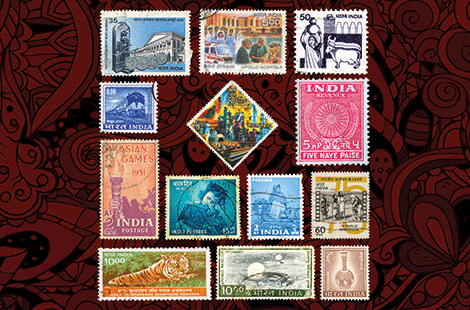As a silent witness to history, the postage stamp packs a power that belies its petite presence on a host of documents across the world. Since the issuance of the Penny Black, the world’s first prepaid postage stamp in Great Britain in 1840, people have been fascinated by how the humble stamp reflects the identity of a nation, records its progress and illustrates its history and heritage.
The Indian Post Office was established under the British East India Company in 1837, and the Scinde Dawk — Asia’s first adhesive stamp — was issued in 1852 by its administrator of the province of Sind, quite aptly the cradle of civilisation in the Indian subcontinent. In the 165 years since, stamps with powerful images and artistic miniatures have been an integral part of India’s cultural heritage, mirroring the nation’s landmark moments and the associated people and projects.
The first commemorative stamp in independent India, pictured above, was issued on November 21, 1947 and depicted the new national flag. Subsequent stamps in the next couple of years showcased the Ashok pillar, India’s national emblem, the nation’s first flight, the father of the nation, Mahatma Gandhi, and a series depicting the nation’s cultural heritage with Hindu, Buddhist, Muslim, Sikh and Jain temples, sculptures, monuments and fortresses.
Since then India Post has issued more than 3,000 stamps, ranging from the mundane to the eccentric, telling the story of this young nation with an ancient lineage and its aspirations, achievements and socio-economic milestones.
While the art of sending handwritten letters franked by postage stamps has been irrevocably lost in our WhatsApp world, it is heartening to note that India Post, under the Ministry of Communication, has continued to commemorate India’s narrative of progress.
As the nation celebrates the 70th anniversary of its independence, we invite you to join us on a philatelic journey through the world’s largest democracy. While researching this report, Team GN Focus enjoyed a nostalgic — even romantic — ride into India over the past seven decades. In many ways, these stamps are emblematic of India’s evolution as an economic powerhouse and proof of its diverse social fabric. We hope our carefully curated selection inspires your own trip down memory lane.
Happy Independence Day!
As a silent witness to history, the postage stamp packs a power that belies its petite presence on a host of documents across the world. Since the issuance of the Penny Black, the world’s first prepaid postage stamp in Great Britain in 1840, people have been fascinated by how the humble stamp reflects the identity of a nation, records its progress and illustrates its history and heritage.
The Indian Post Office was established under the British East India Company in 1837, and the Scinde Dawk — Asia’s first adhesive stamp — was issued in 1852 by its administrator of the province of Sind, quite aptly the cradle of civilisation in the Indian subcontinent. In the 165 years since, stamps with powerful images and artistic miniatures have been an integral part of India’s cultural heritage, mirroring the nation’s landmark moments and the associated people and projects.
The first commemorative stamp in independent India, pictured above, was issued on November 21, 1947 and depicted the new national flag. Subsequent stamps in the next couple of years showcased the Ashok pillar, India’s national emblem, the nation’s first flight, the father of the nation, Mahatma Gandhi, and a series depicting the nation’s cultural heritage with Hindu, Buddhist, Muslim, Sikh and Jain temples, sculptures, monuments and fortresses.
Since then India Post has issued more than 3,000 stamps, ranging from the mundane to the eccentric, telling the story of this young nation with an ancient lineage and its aspirations, achievements and socio-economic milestones.
While the art of sending handwritten letters franked by postage stamps has been irrevocably lost in our WhatsApp world, it is heartening to note that India Post, under the Ministry of Communication, has continued to commemorate India’s narrative of progress.
As the nation celebrates the 70th anniversary of its independence, we invite you to join us on a philatelic journey through the world’s largest democracy. While researching this report, Team GN Focus enjoyed a nostalgic — even romantic — ride into India over the past seven decades. In many ways, these stamps are emblematic of India’s evolution as an economic powerhouse and proof of its diverse social fabric. We hope our carefully curated selection inspires your own trip down memory lane.
Happy Independence Day!






